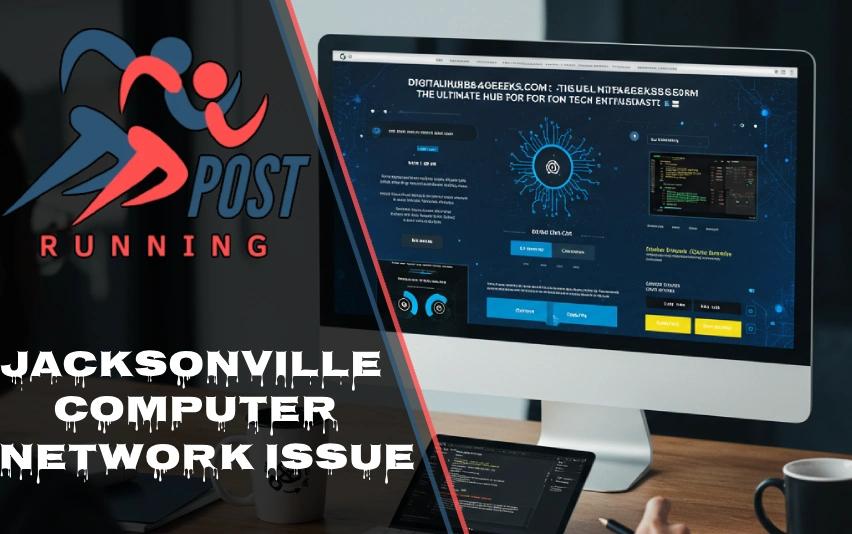In September 2024, the city of Jacksonville, Florida, found itself grappling with an unexpected and far-reaching problem: a major computer network issue that brought many of its digital services to a grinding halt. This Jacksonville computer network issue wasn’t just a minor hiccup; it was a full-blown crisis that affected everything from city websites to emergency services. Let’s dive into what happened, why it matters, and how the city responded to this digital disaster.
What Went Wrong?
At the heart of the Jacksonville computer network issue was a critical hardware failure. It wasn’t a dramatic cyber-attack or a sneaky hacker causing trouble. Instead, it was more like the city’s digital nervous system had a major short circuit. This breakdown sent shockwaves through Jacksonville’s entire digital infrastructure, leaving city officials scrambling to keep essential services running.
The problem first reared its ugly head on September 13, 2024. Suddenly, websites that residents relied on for important information, like jacksonville.gov and jaxready.com, went dark. It was as if someone had pulled the plug on the city’s online presence. But the issues didn’t stop there. The popular 630-CITY helpline, which many residents used to report problems or get information, also went down. Even city mobile apps, which people used for everything from paying parking tickets to checking library hours, stopped working.
A Timeline of Trouble
Let’s break down how this digital drama unfolded:
- September 13, 2024: The city’s network starts acting up, and services begin to fail.
- September 14, 2024: Realizing the severity of the situation, Jacksonville officials reach out to the big guns – the FBI and Homeland Security – for help and guidance.
- March 3, 2025: Fast forward several months, and the city is still working on fully resolving the issue. It’s been a long and bumpy road to recovery.
City Services in Chaos
The Jacksonville computer network issue didn’t just inconvenience a few people; it threw a wrench into the works of many city departments. The Public Defender’s Office, for instance, found itself in a technological quagmire. They were left troubleshooting their systems while trying to keep up with their important work in the justice system.
Imagine trying to report a pothole, pay a water bill, or get information about a city event – all of these everyday tasks became much more complicated overnight. It was like the city had suddenly been transported back to the pre-internet era, with many services reverting to manual, offline methods.
Fighting Back: The City’s Response
Jacksonville’s leaders didn’t just sit back and watch the chaos unfold. They sprang into action:
- The Emergency Operations Center was partially activated. This is the kind of response you’d expect for a natural disaster, showing just how seriously the city took this digital crisis.
- A team of tech experts was assembled to monitor the network around the clock. These digital firefighters worked tirelessly to patch up the system and get services back online.
- Gradually, services started coming back to life. Most city offices managed to restore at least some of their functions, though it was a slow and sometimes frustrating process.
Why Do These Things Happen?
While the Jacksonville computer network issue was a big deal, it’s not entirely uncommon. Cities and organizations around the world often face similar challenges. Some common culprits behind network issues include:
- Configuration errors: Sometimes, it’s as simple as a misplaced comma in a line of code or a wrongly set parameter.
- Bandwidth limitations: As cities grow and more services go online, networks can struggle to keep up with the increased data flow.
- Environmental factors: Believe it or not, things like severe weather can play havoc with network infrastructure. A well-placed lightning strike or flood can cause major problems.
Learning from the Crisis
Every cloud has a silver lining, and even this digital storm taught Jacksonville some valuable lessons:
- Proactive maintenance is key: Regular check-ups and updates can prevent small issues from becoming big problems.
- Redundancy saves the day: Having backup systems and alternative ways of delivering services can keep a city running even when its main network is down.
- Early warning systems are crucial: The sooner a problem is detected, the faster it can be fixed. Enhanced monitoring systems can catch issues before they spiral out of control.
Building a Stronger Digital Jacksonville
In response to this crisis, Jacksonville didn’t just fix the immediate problem; they took steps to prevent future issues:
- Hardware upgrades: Out with the old, in with the new. The city invested in more robust and up-to-date equipment.
- Beefed-up cybersecurity: Even though this wasn’t a cyber-attack, the crisis highlighted the need for stronger digital defenses.
- Better crisis communication: The city developed new strategies to keep residents informed during future tech troubles.
Diagnosing a Computer Network Issue in Jacksonville
Effective troubleshooting is essential for identifying and resolving network issues. Below is a streamlined approach to diagnosing and addressing common computer network problems in Jacksonville:
Step 1: Inspect Hardware Connections
Begin by checking all hardware connections. Ensure the modem, router, and connected devices are powered on and properly connected. Look for loose cables or indicator lights that signal potential issues.
Step 2: Restart Devices
Power cycling your modem, router, and computer can often resolve temporary glitches. Turn off each device, wait for at least 60 seconds, and then restart them.
Step 3: Use Diagnostic Tools
Leverage built-in diagnostic tools available on most devices. For example, Windows users can run the Network Troubleshooter via the Control Panel to identify connectivity issues or configuration conflicts.
Step 4: Verify ISP Status
Check with your Internet Service Provider (ISP) for any outages in the Jacksonville area. This can be done by visiting their website or contacting customer support, as some problems may stem from regional disruptions.
Step 5: Update Drivers and Software
Ensure that your network drivers and related software are up-to-date. Outdated drivers may cause compatibility issues or degrade performance.
Wrapping Up: A Wake-Up Call for Modern Cities
The Jacksonville computer network issue serves as a stark reminder of how dependent our cities have become on digital infrastructure. It’s not just about convenience; it’s about keeping essential services running and ensuring public safety.
This crisis showed that even a seemingly small hardware failure can have far-reaching consequences. It underscored the need for cities to invest in robust, resilient IT systems that can withstand failures and recover quickly.
As we move further into the digital age, the lessons learned from Jacksonville’s experience will be valuable not just for this Florida city, but for urban centers around the world. It’s a call to action for city planners and administrators everywhere to take a hard look at their digital infrastructure and ask themselves: Are we prepared for the worst?
In the end, the Jacksonville computer network issue wasn’t just about broken hardware or offline websites. It was about a city facing a 21st-century challenge and finding ways to adapt, recover, and emerge stronger. It’s a story of resilience in the face of technological adversity, and a lesson in the importance of being prepared for the unexpected in our increasingly digital world.
Discover more fascinating insights—explore Running Posts Today.















